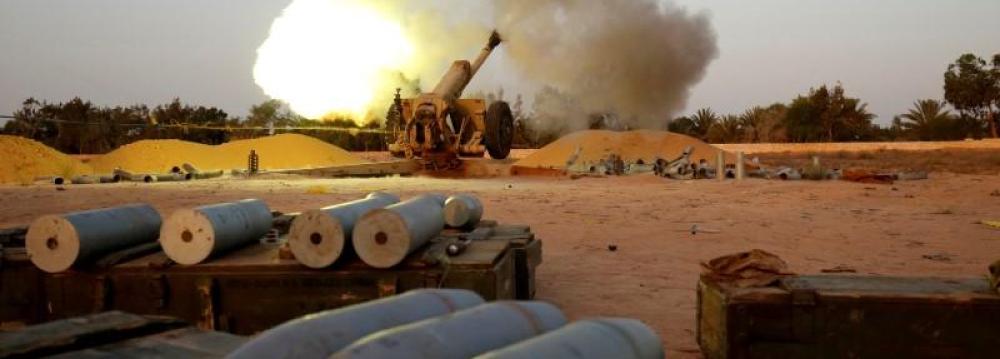US planes targeted the self-styled Islamic State terrorist group in Libya on Monday, responding to the UN-backed government’s request to help push the militants from their former stronghold of Sirte in what US officials described as the start of a sustained campaign against the extremist group in the city.
“The first airstrikes were carried out at specific locations in Sirte today causing severe losses to enemy ranks,” Libyan Premier Fayez Seraj said on state TV, Reuters reported.
Pentagon spokesman Peter Cook said the strikes did not have “an end point at this particular moment in time”.
Forces allied with Seraj have been battling IS in Sirte—the home town of former dictator Muammar Gaddafi—since May.
The militants seized the Mediterranean coastal city last year, making it their most important base outside Syria and Iraq. But they are now besieged in a few square kilometers of the center, where they hold strategic sites, including the Ouagadougou conference hall, the central hospital and the university.
Seraj said the Presidential Council of his Government of National Accord, or GNA, had decided to “activate” its participation in the international coalition against IS and “request the United States to carry out targeted airstrikes on Daesh (another name of IS).”
The airstrikes on Monday, which were authorized by US President Barack Obama, hit an IS tank and two vehicles that posed a threat to forces aligned with Libya’s GNA, Cook said.
In the future, each individual strike will be coordinated with the GNA and needs the approval of the commander of US forces in Africa, Cook added.
This was the third US airstrike against IS militants in Libya. But US officials said this one marked the start of a sustained air campaign rather than another isolated strike.
The last acknowledged US airstrikes in Libya were on an IS training camp in the western city of Sabratha in February.
Although it does not include the use of ground troops beyond small special forces squads rotating in and out of Libya and drones collecting intelligence, the air campaign opens a new front in the war against IS and what American officials consider its most dangerous component outside Syria and Iraq.
Obama authorized the strikes after a recommendation by US Secretary of Defense Ash Carter. Washington took part in airstrikes in 2011 to enforce a no-fly zone in Libya, which helped topple Gaddafi. The country has struggled since then and Obama said in an interview with The Atlantic magazine in April that the intervention “didn’t work”.
Operations in Sirte and Suburbs
“I want to assure you that these operations are limited to a specific timetable and do not exceed Sirte and its suburbs,” Seraj said, adding that international support on the ground would be limited to technical and logistical help.
“GNA-aligned forces have had success in recapturing territory from ISIL (another acronym of IS) thus far around Sirte, and additional US strikes will continue to target ISIL in Sirte in order to enable the GNA to make a decisive, strategic advance,” said Cook, the Pentagon spokesman.
The White House said US assistance to Libya would be limited to airstrikes and information sharing.
“There are unique capabilities that our military can provide to support forces on the ground and that’s what the president wanted to do,” White House spokesman Eric Schultz told reporters on Air Force One on Monday.
But that coordination will be a challenge, experts said.
Local forces in Libya fighting IS are diffuse and fragmented, with no single center of command, said Frederic Wehrey, a Libya expert at the Carnegie Endowment for International Peace in Washington who recently spent three days with fighters in Sirte.
“US and western diplomatic strategy has been to try to boost this GNA, but I think there are certain limits,” Wehrey said. “It’s not the sort of conventional military operation we would think of where there’s a central point of contact.”
US and Libyan officials estimate that several hundred IS fighters remain in Sirte.
Brigades mainly composed of militia from the western city of Misrata advanced on Sirte in May, but their progress was slowed by snipers, mines and booby-traps.
Those forces have complained that assistance from the government in Tripoli and external powers was slow to materialize. At least 350 of their fighters have been killed and more than 1,500 wounded in the campaign.
Libyan fighter jets have frequently bombed Sirte, but they lack the weapons and technology to make precision strikes.
IS took advantage of political chaos and a security vacuum to start expanding into Libya in 2014. It gained control over about 250 km of sparsely populated coastline either side of Sirte, though it has struggled to win support or retain territory elsewhere in the country.
The GNA was the result of a UN-mediated deal signed in December to end a conflict between two rival governments and the armed groups that supported them. But it is having difficulty imposing its authority and winning backing from factions in the east.


